

Republic Aviation Corporation F-105 Thunderchief "Thud" instrument panels. Nose section of a USAF F-105B aircraft with "buzz Number" FH-100 (Tail No. 40100) showing the blue-red F-105 Thunderchief logo as nose art.
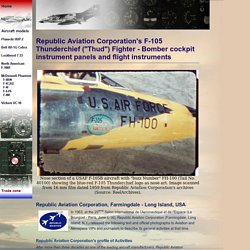
Image scanned from 16 mm film dated 1959 from Republic Aviation Corporation's archives (Source: ReelArchives). Republic Aviation Corporation, Farmingdale - Long Island, USA In 1963, at the 25eme Salon International de l'Aeronautique et de l'Espace (Le Bourguet - Paris, June 6-16), Republic Aviation Corporation (Farmingdale, Long Island, N.Y.) released the following text and official photographs to Aviation and Aerospace VIPs and journalists to describe its general activities at that time. Republic Aviation Corporation's profile of Activities After more then three decades as one of the leading aircraft manufacturers, Republic Aviation Corporation's activities have expanded to cover a wide spectrum of advanced aircraft, electronics and space system development and procedures.
Since 1931, Republic has produced nearly 25,000 aircraft. 15 Types of missions. 561st Tactical Fighter Squadron Archives - This Day in Aviation. 2 March 1978: Major Charles T.
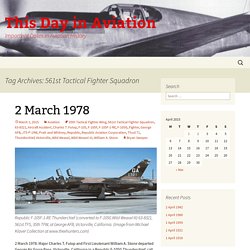
Fulop and First Lieutenant William A. Stone departed George Air Force Base, Victorville, California in a Republic F-105G Thunderchief, call sign THUD 71. Their mission was a routine instrument training flight, making instrument approaches and departures at NAS Point Mugu on the California coast, then return to George AFB. Republic F-105 Thunderchief - Fighter-Bomber / Reconnaissance / Wild Weasel. The F-105 Thunderchief was a Cold War product of the Republic Aviation Corporation and became the company's last production aircraft before its merger with Fairchild.
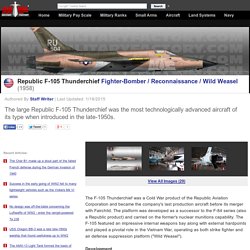
The platform was developed as a successor to the F-84 series (also a Republic product) and carried on the former's nuclear munitions capability. The F-105 featured an impressive internal weapons bay along with external hardpoints and played a pivotal role in the Vietnam War, operating as both strike fighter and air defense suppression platform ("Wild Weasel"). Joint Strike Fighter = Thunderchief II? / Back to the Future in Battlefield Interdiction. First flight of SDD JSF Prototype AA-1 in December, 2006.
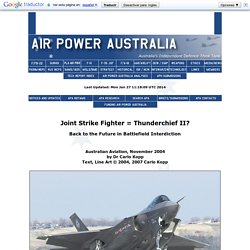
This aircraft is a 'non-representative prototype' which predates in construction a series of structural and systems weight reduction measures. The aircraft is equipped with a dummy EOTS fairing under the nose (Imagery via Air Force Link). The new Joint Strike Fighter (JSF) program is often compared to the early nineteen sixties Tactical Fighter eXperimental (TFX/F-111) program, reflecting the multi-service structure of both programs. In concept and sizing, however, the JSF is very much closer to another early nineteen sixties tactical fighter, the Republic AP-63 series F-105 Thunderchief. Rolling Thunder escalated US involvement in Vietnam's civil war, pulled ground troops into combat - Vietnam at 50.
In 1964, Keith Connolly was a young Air Force pilot and was among the first Americans to fly sorties in the F-100 Super Sabre fighter bomber targeting the North Vietnamese communist insurgency.
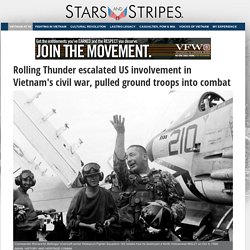
“The atmosphere was that we were going over there to provide the firepower necessary to bring the North Vietnamese to their knees,” said Connolly, who now lives in Arizona after retiring from 35 years in the Air Force. The average American back then paid scant attention to the long-simmering civil war on the Indochina peninsula, where the U.S. had sent military advisors but was not yet involved in direct ground combat. “It was the only war in town, and it was going to be over with tomorrow,” Connelly recalled. “Boy, were we wrong.” On March 2, 1965, the U.S. commenced such bombing raids in earnest with Operation Rolling Thunder, a massive, joint Navy-Air Force campaign of more than 300,000 attack sorties over 3½ years. “It was just a mess, from start to finish,” said James H. No magic formula Col. The Republic F-105 Thunderchief. v1.0.2 / 01 jan 03 / greg goebel / public domain * The Republic "F-105 Thunderchief" was conceived in the 1950s as a nuclear strike aircraft, but would achieve fame in the Vietnam War as the "Thud", a conventional strike and "defense suppression" aircraft.

This document provides a short history of the F-105. * In 1951, a design team under Alexander Kartveli at Republic Aircraft began work as a company venture on a new high-performance, single-seat low-level nuclear strike aircraft. The new aircraft, which was given the company designation of "AP-63", where "AP" stood for "Advanced Project", was to replace the Air Force's Republic F-84F Thunderstreak. Many different design concepts were considered, gradually evolving towards something along the lines of a "stretched" F-84F with a bombbay for a nuclear weapon. REPUBLIC F-105. Republic F-105D Thunderchief. In 1951 Republic Aviation began a project to develop a supersonic tactical fighter-bomber to replace the F-84F.
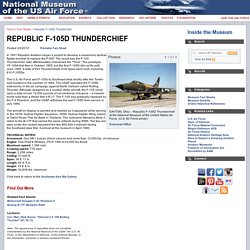
The result was the F-105 Thunderchief, later affectionately nicknamed the "Thud. " The prototype YF-105A first flew in October 1955, but the first F-105D did not fly until June 1959. A total of 833 Thunderchiefs of all types were built, including 610 F-105Ds. The U.S. Air Force sent F-105s to Southeast Asia shortly after the Tonkin Gulf incident in the summer of 1964. The aircraft on display is painted and marked as it appeared while serving in the 357th Tactical Fighter Squadron, 355th Tactical Fighter Wing, based at Takhli Royal Thai Air Base in Thailand. TECHNICAL NOTES: Armament: One M61 Vulcan 20mm cannon and more than 12,000 lbs. of ordnanceEngine: One Pratt & Whitney J75-P-19W of 24,500 lbs thrustMaximum speed: 1,390 mphCruising speed: 778 mphRange: 2,206 milesCeiling: 51,000 ft.Span: 34 ft. 11 in.Length: 64 ft. 5 in.Height: 19 ft. 8 in.Weight: 52,838 lbs. maximum.
Vietnam War - F-105 Thunderchief Profile. Specifications: General Length: 64 ft. 4.75 in.
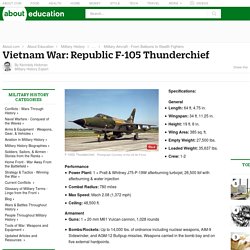
Wingspan: 34 ft. 11.25 in. Height: 19 ft. 8 in. Wing Area: 385 sq. ft. Performance Power Plant: 1 × Pratt & Whitney J75-P-19W afterburning turbojet, 26,500 lbf with afterburning & water injection Combat Radius: 780 miles Max Speed: Mach 2.08 (1,372 mph) Ceiling: 48,500 ft. Armament Guns: 1 × 20 mm M61 Vulcan cannon, 1,028 rounds Bombs/Rockets: Up to 14,000 lbs. of ordnance including nuclear weapons, AIM-9 Sidewinder, and AGM-12 Bullpup missiles. Craig Baker's F-105 Site, The Awesome Thunderchief. Republic F-105 Thunderchief. The Republic F-105 Thunderchief was a supersonic fighter-bomber used by the United States Air Force.

The Mach 2 capable F-105 conducted the majority of strike bombing missions during the early years of the Vietnam War; it was the only U.S. aircraft to have been removed from combat due to high loss rates.[2] Originally designed as a single-seat, nuclear-attack aircraft, a two-seat Wild Weasel version was later developed for the specialized Suppression of Enemy Air Defenses (SEAD) role against surface-to-air missile sites. The F-105 was commonly known as the "Thud" by its crews. As a follow-on to the Mach 1 capable North American F-100 Super Sabre, the F-105 was also armed with missiles and a cannon; however, its design was tailored to high-speed low-altitude penetration carrying a single nuclear weapon internally.
Republic F-105 Thunderchief. The Republic F-105 Thunderchief Copyright ©2002 Tor Willy Austerslått Also published on Everything2 If you had been on the ground somewhere in the Vietnam War and looked skywards upon hearing the roar of jet engines, the odds of it being a flight of F-105 Thunderchiefs would have been good.
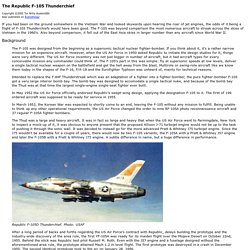
The F-105 was beyond comparison the most numerous aircraft to streak across the skies of Vietnam in the 1960's. Also beyond comparison, it fell out of the East Asia skies in larger number than any aircraft since World War II. Background. F-105 Thunderchief. Republic F-105 Thunderchief was a United States single-seat and two-seat, supersonic fighter-bomber; used during the Cold War and in the Vietnam War. §In action[edit] F-105 Thunderchief taking offF-105 Thunderchief undersideF-105 Thunderchiefs refuelF-105D Thunderchiefs refuelF-105 Thunderchief left rear viewthree F-105 and two TA-4Jfour F-105 in diamond formationF-105G mounted AGM-45 Shrike and AGM-78B Standard ARMThe 24-ship flyover formation, Diamonds on Diamonds, was used at the F-105 retirement at Hill Air Force Base in 1985 §Static displays[edit]
Thuds, the Ridge, and 100 Missions North. Republic F-105 Thunderchief.